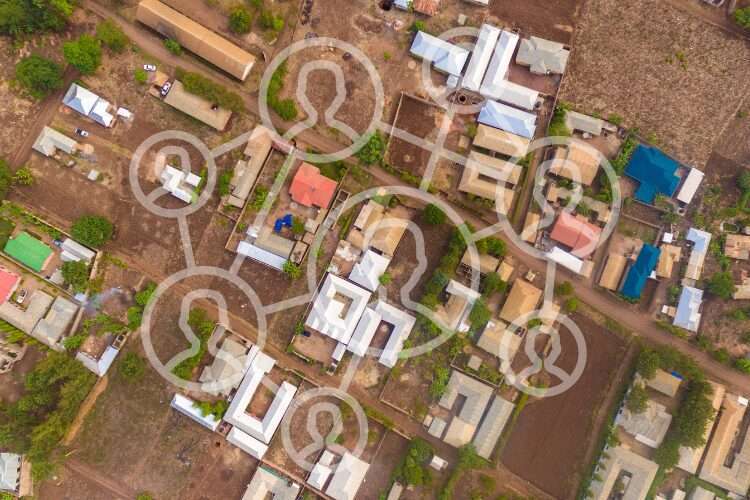Answered: What is Hyperlocal Social Media Marketing?

Hyperlocal social media marketing refers to marketing tactics and strategies implemented on social media platforms to target and engage consumers within a very small and localized geographic area.
This could be a specific neighborhood, city district, individual suburb, or town. Brands utilize hypertargeted ads, organic unpaid posts, and other highly personalized content to appeal to social media users based specifically on their location and close proximity to a business.
Done effectively, hyperlocal social media marketing helps businesses promote themselves and sell products or services to local audiences cost-effectively while competing against national chains and ecommerce sites.
For potential customers, it provides visibility and access to local offerings in their city that are relevant to them.
In this guide, we’ll explore what hyperlocal social media marketing looks like, who it works for, why it’s useful in driving neighborhood engagement and conversions, plus strategies and best practices businesses should apply when running hyperlocal campaigns.
What Types of Businesses Benefit from Hyperlocal Marketing?
Hyperlocal social media marketing is extremely valuable for service-based businesses with physical locations that cater to local residents city by city. Prime examples include:
1. Restaurants
Especially individually owned establishments rather than nationwide chains, hyperlocal campaigns allow restaurants to make nearby residents aware of their eateries through ads, promote daily specials or events, facilitate online orders, recruitment, and highlight positive reviews by neighbors.
2. Cafes & Bakeries
Like restaurants, cafes and bakeries thrive on business from locals popping in regularly.
Hyperlocal campaigns showcase their house specialties, new menu launches, seasonal treats, and special order options popular around various holidays.
3. Salons & Spas
These businesses require patrons to physically visit to utilization services, making location-based targeting essential.
Hyperlocal social media marketing conveys proximity for convenience, availability of sought-after treatments, promotions like first-time discounts, and even ability to book directly.
4. Gyms & Fitness Studios
Fitness centers similarly rely on neighborhood residents signing up for memberships and classes.
Hyperlocal campaigns can feature virtual tours of facilities, introductions to coaches, class times and descriptions, free trial offers, and spotlight member success stories.
5. Event Venues
Event spaces like conference halls, wedding venues, theaters, and banquet rooms utilize hyperlocal marketing to make nearby event planners and couples aware of offerings for upcoming functions and available dates through social media channels.
Essentially most customer-facing enterprises from dentist offices to pet stores that require foot traffic can amplify awareness and conversions through hyperlocal social media marketing.
The Value of Hyperlocal Social Media Marketing
Here are some of the major benefits that hyperlocal social media marketing offers over mass nationwide campaigns:
Laser-Focused Targeting
By limiting ads and organic unpaid posts to only users within a 5-mile radius for instance, businesses see higher relevance, engagement rates and clicks for less cost.
Content also resonates more when referencing known neighborhoods.
Drive Foot Traffic to Physical Locations
Efforts culminate in getting nearby residents to actually visit stores thanks to location-based tags, mapping integrations, clickable addresses and calls-to-action prompting visits. This is invaluable for purchase conversions.
Compete with Big Chains
Individual local businesses can level the playing field against nationally recognized brands and ecommerce sites based on proximity and convenient access for neighboring customers.
Own Search Results
Execution of hyperlocal campaigns factors into local SEO optimization to help lockdown map packs, business listings, search rankings and reviews in Google when consumers search for local options.
Community Engagement
Interacting 1:1 with residents and answering their questions fosters a tight-knit community feel that keeps customers loyal and engaged with the brand.
Granular Insights
Analytics from hyperlocal initiatives reveal which neighborhoods, demographics, and personas are most interested that can inform ongoing targeting and creative strategies.
Flexible Budgets
Hyperlocal requirements allow for smaller budgets compared to national efforts while still making an impact on those most likely to buy based on close range.
When social media marketing is specifically optimized to engage those in the surrounding area of each respective physical location, brands see the highest ROI in driving conversions both digitally and in-store.
Hyperlocal Social Media Marketing Strategies
Here are some proven hyperlocal social media marketing strategies and tactics to incorporate:
1. Geo-Limit Organic Posts
When publishing daily social updates natively rather than through ads, reduce the geographic reach manually to only target users within a set mile radius or specific zip codes.
This focuses engagement from nearby residents.
2. Spotlight Specific Neighborhoods
Call out by name certain neighborhoods, boroughs, districts and cross streets that your location serves. This grabs attention from hyperlocal crowds.
3. Hashtag Neighborhoods Too
Similarly hashtag the various hyperlocal areas to embed posts into community conversations online residents follow. #EastVillage #UpperWestSide #DowntownBrooklyn
4. Cross-Promote hashtags
Also hashtag the city name like #Boston and neighborhood nicknames like #Beantown to cast a wider net geographically.
5. Hyper-Target Local Interests
Identify the niche local interests and conversational keywords neighbors discuss online and integrate those organically like sports teams, events, weather, traffic, community issues, etc.
6. Leverage UGC Content
Repurpose and showcase authentic User Generated Content from customers organically sharing their first-hand positive reviews, experience and photos at your location.
7. Coordinate Check-Ins
Encourage supporters to tag themselves physically at your location using apps like Swarm to notify their networks. Nearby friends see the activity.
8. Call Out Limited-Time, Location Exclusive Perks
Detail special discounts, menu items, treatments or events only offered at one location or for a short promotional period to create urgency and FOMO to visit.
9. Spotlight Limited Quantities
When showcasing specialty offerings or product launches, convey the exclusivity of limited quantities to prompt quick action.
10. On-Site Contests & Giveaways
Boost foot traffic by promoting in-store contests, giveaways and games open only to those who visit before a deadline. Reinforce location specifics.
11. Leverage Influencers
Recruit popular city-based influencers from various niches to organically showcase and recommend your location/services from their local lifestyle angle.
Optimizing Hyperlocal Social Media Marketing Paid Social Ads
While organic hyperlocal social media marketing drives great value, running paid ads geo-targeted to different regions and neighborhoods takes results to the next level. Some best practices include:
1. When setting campaign location parameters in the backend, reduce targeting to only those within a 5-15 mile radius depending on business, or target by zip codes.
2. Prominently reference the city name, borough, neighborhoods, cross streets and distance from well-known landmarks residents relate to.
3. Enable location tagging so ads populate on the geo-located pages and feeds of anyone who has enabled Nearby Notifications.
4. Include hashtags for the city and specific areas you service so ads appear in those hyperlocal community discussions.
5. Develop ads around special discounts, bundles, promotions and seasonal offerings only available at nearby locations for a limited-time. Convey urgency.
6. Embed clickable location addresses that navigate to a visible local map view upon clicking.
7. Knowing consumers are closeby, craft simple CTAs like “Drop In Now”, “Come Today Only”, or “Book Before X Date”.
8. Custom audiences help you further target ads to those who recently visited the location, browsed the website menu or scheduled an online appointment.
9. Produce multiple ad variations spotlighting menu items, facilities, distances and neighborhood feel to see what imagery and copy resonates most in driving actions based on analytics.
Measuring Hyperlocal Social Media Marketing Performance
It’s important to closely track hyperlocal social media marketing performance using precise metrics:
1. Engagement From Local Followers
Calculate what % of overall social engagement (likes, shares, comments) is driven by followers specifically from surrounding neighborhoods. Benchmark then work to increase.
2. Net New Local Followers
Track the increase in location-based followers week-over-week as an indicator of growing neighborhood visibility.
3. Physical Store Traffic Uplift
Compare web analytics from recent hyperlocal initiatives to foot traffic increases by neighborhood or efforts that drove the highest in-store visits.
4. Local Conversions
Tie closed sales both online and in-store back to recent hyperlocal ads people interacted with showing clear path to conversion.
5. Cost Per Conversion By Market
Calculate CPC benchmarks for each hyper-targeted area and optimize those yielding the lowest cost per conversion result.
6. Sentiment & Review Analysis
Monitor how favorability, sentiment scores and review ratings shift specifically from hyper-targeted local areas as you ramp up community-building marketing.
7. Lifetime Value From Locals
Analyze customer value produced from high-converting surrounding neighborhoods to prioritize ongoing ad spend and business focus towards the most lucrative areas and loyal neighbors.
8. Competitor Differences
Research how your hyperlocal performance and presence stands out from competing brands in the area also vying for local attention. Identify strengths and gaps.
9. Opened Location Notifications
Within platforms like Facebook, track how many users engage with notifications that they’re near new location openings to gauge interest.
10. Ad Recall Lifts
Conduct periodic surveys with customers from recent hyperlocal efforts to identify upticks in unaided brand awareness, location familiarity and ad recall attributable to the campaigns.
Keys to Success with Hyperlocal Social Media Marketing
Implementing the following best practices sets your hyperlocal social media marketing efforts up for maximum impact within surrounding neighborhoods:
1. Commit to an ongoing cadence of daily or weekly community-relevant posts organically and paid ads customized to different locations. Consistency builds recognition.
2. Officially register your accurate business listings and profiles across major platforms like Google My Business, Facebook Places, Apple Maps and more with your address, hours, photos etc optimized. This facilitates discovery by searchers and maps views.
3. Actively engage when neighbors organically mention your brand by name or tag your location. Being helpful and attentive breeds customer loyalty.
4. Stay abreast of topics locals are discussing online from sports team enthusiasm during big games to frustration around neighborhood construction. Reflect these conversational nuances in relevance.
5. Rotate in new special discounts, bundles, promotions and added value offering on a month-to-month basis to give neighbors incentives to regularly revisit.
5. With permission, repurpose great reviews, testimonials and photos from loyal neighborhood customers in your ads and posts. Their authentic perspectives resonate most.
Wrapping up!
Hyperlocal social media marketing represents an invaluable growth opportunity for brick-and-mortar enterprises looking to amplify their presence and sales within the neighborhoods they serve.
Through a combination of unpaid organic community-building content and paid ads spotlighting proximity-based promotions, location tags, and calls to visit in-store, hyperlocal campaigns pay dividends in driving tangible foot traffic.
They enable enterprises as niche as craft bakeries, chiropractor offices, gyms and salons to effectively compete for business against bigger chains and ecommerce by leveraging their physical access and convenience.
The brands finding success are those committed to engaging consistently across channels, responding to all mentions, conveying limited-time offers tailored to locals, and tracking growth in metrics like neighborhood follower growth and location check-ins.
As platforms continue enhancing options to target by geography and intent down to the local city level, hyperlocal social marketing only grows more crucial. Meet customers where they virtually live nearby; the customer loyalty and sales will thrive for years to come.



